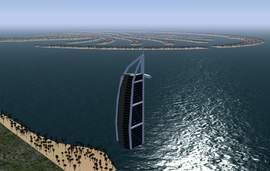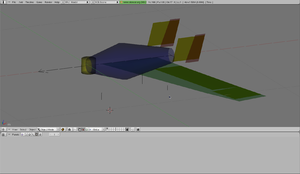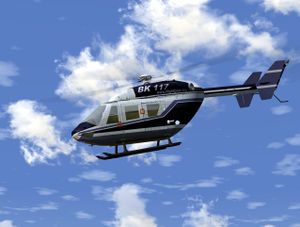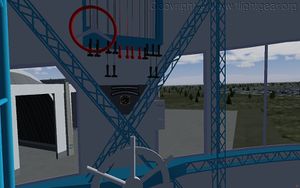FlightGear Newsletter March 2011: Difference between revisions
Papillon81 (talk | contribs) (→Updated aircraft: Concorde TCAS) |
|||
| Line 124: | Line 124: | ||
== Airport of the month == | == Airport of the month == | ||
Martin State Airport (KMTN) north of Baltimore, Maryland may be the best airport in FlightGear you've never heard of. | |||
Make sure you have the object file downloaded, and if you don't have the Baltimore/Washington custom scenery, head over and download the terrain from [[User:statto|statto's]] FlightGear website. Install this properly and you are set to have a quality VFR flight experience! | |||
To start out do a touch-and-go on runway 31. Start your turn over the pattern near the Anne Arundel Mall (a big asphalt blob in the middle of the farmland), then come in over the handcrafted terrain of the harbor. | |||
For a cross-country flight, fly down Baltimore Harbor toward the well-modeled Baltimore-Washington Int'l Airport, then follow the railway and freeway past College Park. Overfly RFK Stadium and the Washington National Mall before turning and landing at Washington National Airport (KDCA). | |||
The custom models combined with the custom scenery really sets this part of the world apart from the default areas in FlightGear - have a flight over Maryland today! | |||
== Screenshot of the month == | == Screenshot of the month == | ||
Revision as of 22:46, 30 March 2011
|
We would like to emphasize that the monthly newsletter can not live without the contributions of FlightGear users and developers. Everyone with a wiki account (free to register) can edit the newsletter and every contribution is welcome. So if you know about any FlightGear related projects such as for example updated scenery or aircraft, please do feel invited to add such news to the newsletter.
FlightGear events
Development news
Local Weather v1.0
After more than a year of development work, the Local Weather package has reached its full design functionality as described in A local weather system and is available for download as version 1.0. The package works with Flightgear 2.0.0 and higher, though some extensions (marked with [GIT]) require a more recent binary.
Version 1.0 offers the following features:
- numerous types of clouds from Cirrus to Cumulonimbus, arranged in realistic patterns and size distributions, visible up to 80 km distance
- weather phenomena tied to location: rain only underneath clouds, dense clouds obscure sunlight [GIT], convective clouds develop according to terrain
- spatial interpolation of weather parameters like pressure, temperature, visibility, wind
- effect volumes controlling short-range turbulence, rain, snow, visibility and shadow [GIT]
- terrain-dependent modeling of boundary layer winds, gusts and turbulence
- complete offline weather system involving different airmass types and weather fronts
- integration of online METAR data [GIT]
- full support for soaring [GIT], thermals are automatically generated by the convective system
- optional dynamics: clouds drift in the wind, convective clouds are generated and decay, properties of thermals evolve in time
- backward compatibility to Flightgear 2.0.0
A feature gallery:
Fun facts:
- lines of Nasal code: 10135
- estimated coffee consumption during coding: 120 l
- estimated time spent watching and photographing the sky: 50 h
Nasal for newbies
New software tools and projects
Modeling a UAV with FlightGear and YASim
FlightGear can be a great tool for aerospace engineering. Here is an example of using the YASim physics engine in FlightGear to model a real world UAV based on the actual mass and geometry and performance of the airframe. There is a Blender plugin that can be used to visualize and validate the geometric data of the model. Once the simulation model is tuned and flying well, FlightGear can be used to do do simple design variation tests and predict how those changes will affect the stability of the design.
For more information: Using FlightGear + YASim to model and test real world UAV
FlightGear addons and mods
In the hangar
New aircraft
DG-101G
A new glider, the DG-101G from Glaser-Dirks, has been added to Git. It utilizes a JSBSim FDM, tuned with data calculated with XFLR5. This model features winch start, aerotowing, a drag robot, water ballast and livery over MP.
BK 117
Work on the BK117 helicopter has been started. The BK117 is a twin-engined medium utility–transport helicopter, produced in a coproduction between MBB/Eurocopter and Kawasaki. It uses the same rigid rotor system like Bo105, but is larger in size and has more power. It is quite common in the world and very often used by emergency services and law enforcements.
The model features a realistic FlightDynamicModel based and calculated from NASA-reports, a detailed 3d-model with normalmap and reflection shaders, detailed rotor (thanks to Melchior!) and will be dynamically configurable in many variants. It is planned to make it realistic as it can be and good or even better than the Ec130 B4.
Next steps are the interior modeling with a detailed 3d-cockpit. Please follow the process in the forum.
Updated aircraft
LZ 121 Nordstern
The Zeppelin LZ 121 Nordstern has been updated with a new gas and ballast control board by Anders.
Concorde TCAS
Chris (papillon81) took care of the Concorde's TCAS and converted it to the new generic system by ThorstenB. The old Concorde-specific one was implemented using NASAL and xml and he got rid of about 1800 LOC in the process. He also created a new glass instrument (the only one in the Concorde's cockpit), modeled according to some web sources. The new system works with both AI and multiplayer traffic.
Livery database reaches 400
This month the FlightGear livery database welcomed its 400th livery! A big thank you to all those artists that contributed over the past two years. A special thank you is justified for gooneybird, who saw his 150th livery commited this month, making him by far the top-contributer!
If you'd like to help us reach the 500 milestone, please see Howto: Edit a livery and/or the dedicated section of our forum.
Scenery corner

One of world's most famous landmarks, the Taj Mahal in India, is now modeled and included in the scenery database. Dubai also welcomed a new model, the famous hotel Burj al Arab.
Eastern Asia
A bunch of new Asian buildings is added, including:
- Two International Finance Centre - Hong Kong - China
- International Commerce Center - Hong Kong - China
- Shanghai World Finance Center - Shanghai - China
- Jin Mao Tower - Shanghai - China
- Tuntex Sky Tower - Kaohsiung - Taïwan
- Northeast Asia Trade Tower - Incheon - South Korea
- 63 Building - Seoul - South Korea
- N Seoul Tower - Seoul - South Korea
Airports
Full scale 747 simulator
As you might know, John Wojnaroski has been working for several years on a full-scale 747 simulator, powered by FlightGear. Recently he published two videos, showing the current status of the sim. Recent developments were focused on a panoramic display.
The projectors are (3) short throw 1200x800 native resolution units, mounted on the ceiling. Each projector is first mechanically aligned using the projector test pattern. Next a warping mesh based on projector location and screen dimensions is created and a test pattern using the mesh is produced by FlightGear. The warping mesh is then adjusted to tune the resultant image thrown on the screen as well as mechanical adjustments. And as a final step the "production" image is adjusted by setting the viewing heading for the side projectors for horizontal alignment and projector internals and mesh recalculations for the vertical as required.
The image warping software is contained in the CameraGroup.cxx based on the OSG code for a spherical panoramic display. Tim Moore adapted the source to run with the FlightGear camera group and I extended it to display a warping mesh for a cylindrical panoramic display. There is a stand alone utility to create a mesh warping file that can be tailored for each projector and is loaded at FG init time.
The edge blending is accomplished using gray scale polygons as textures. Further refinement is required to adjust the gamma function to handle pixel brightness based on RGB color values. The slight image flickering is an artifact of the projector and video camera sync mismatches and not observable by the human eye. The videos don't really capture the immersive quality of the wrap-around screen or sensation of motion.
The FG hosting machine is a quad-core Intel I5 with 4GB memory and three nVidia 9400GT graphics. Running FG on a single core produces a frame rate of 28fps using SDL and around 30fps with glut-3.7 with 3D clouds enabled. A higher frame rate of 60-65fps is possible running three instances of fgfs on each core and using the internal localhost socket; however you lose the ability to sync features such as AI traffic, clouds, or multiplayer aircraft.
More info and pictures about the build process are available at John's website and the FlightGear website.
Aircraft of the month
Airport of the month
Martin State Airport (KMTN) north of Baltimore, Maryland may be the best airport in FlightGear you've never heard of.
Make sure you have the object file downloaded, and if you don't have the Baltimore/Washington custom scenery, head over and download the terrain from statto's FlightGear website. Install this properly and you are set to have a quality VFR flight experience!
To start out do a touch-and-go on runway 31. Start your turn over the pattern near the Anne Arundel Mall (a big asphalt blob in the middle of the farmland), then come in over the handcrafted terrain of the harbor.
For a cross-country flight, fly down Baltimore Harbor toward the well-modeled Baltimore-Washington Int'l Airport, then follow the railway and freeway past College Park. Overfly RFK Stadium and the Washington National Mall before turning and landing at Washington National Airport (KDCA).
The custom models combined with the custom scenery really sets this part of the world apart from the default areas in FlightGear - have a flight over Maryland today!
Screenshot of the month
Suggested flights
Aircraft reviews
Wiki updates
New articles
<DynamicArticleList>
type=new count=10
</DynamicArticleList>
New aircraft articles
<DynamicArticleList>
type=new count=10 categoryRoot=Aircraft
</DynamicArticleList>
Most popular newsletters
<DynamicArticleList>
type=hot count=5 categoryRoot=FlightGear Newsletter
</DynamicArticleList>
Community news
FlightGear on YouTube
- Sim's video features a nice aerobatic show, performed with a P-51D Mustang.
New tutorials and screencasts
Forum news
Multiplayer
Virtual airlines
Useful links
And finally ...
Contributing
One of the regular thoughts expressed on the FlightGear forums is "I'd like to contribute but I don't know how to program, and I don't have the time". Unfortunately, there is a common mis-conception that contributing requires programming and lots of free time. In fact, there are a huge range of ways to contribute to the project without needing to write code or spending days working on something.
For ideas on starting to contribute to FlightGear, you may want to check out: Volunteer.
Call for volunteers
The OpenRadar project is looking for a new maintainer.
The TerraGear GUI project is looking for programmers to help create a GUI frontend for TerraGear [1].
The FGFSPM (FlightGear Package Manager) is looking for a new maintainer.















